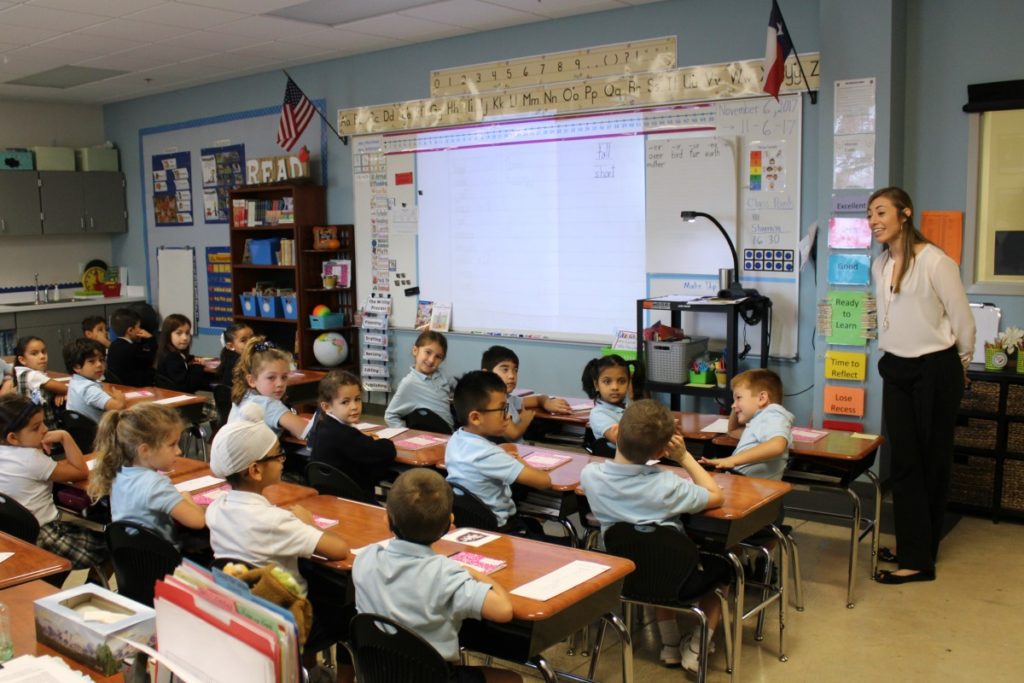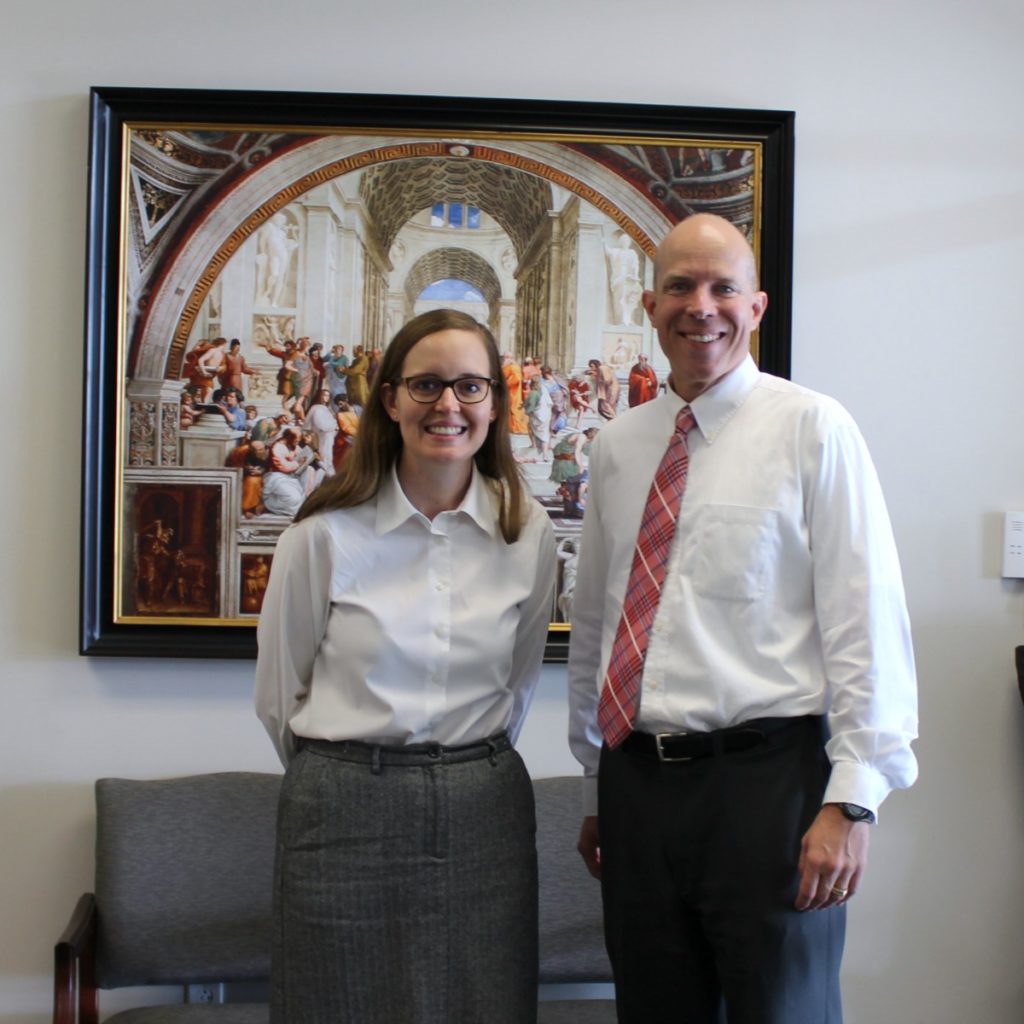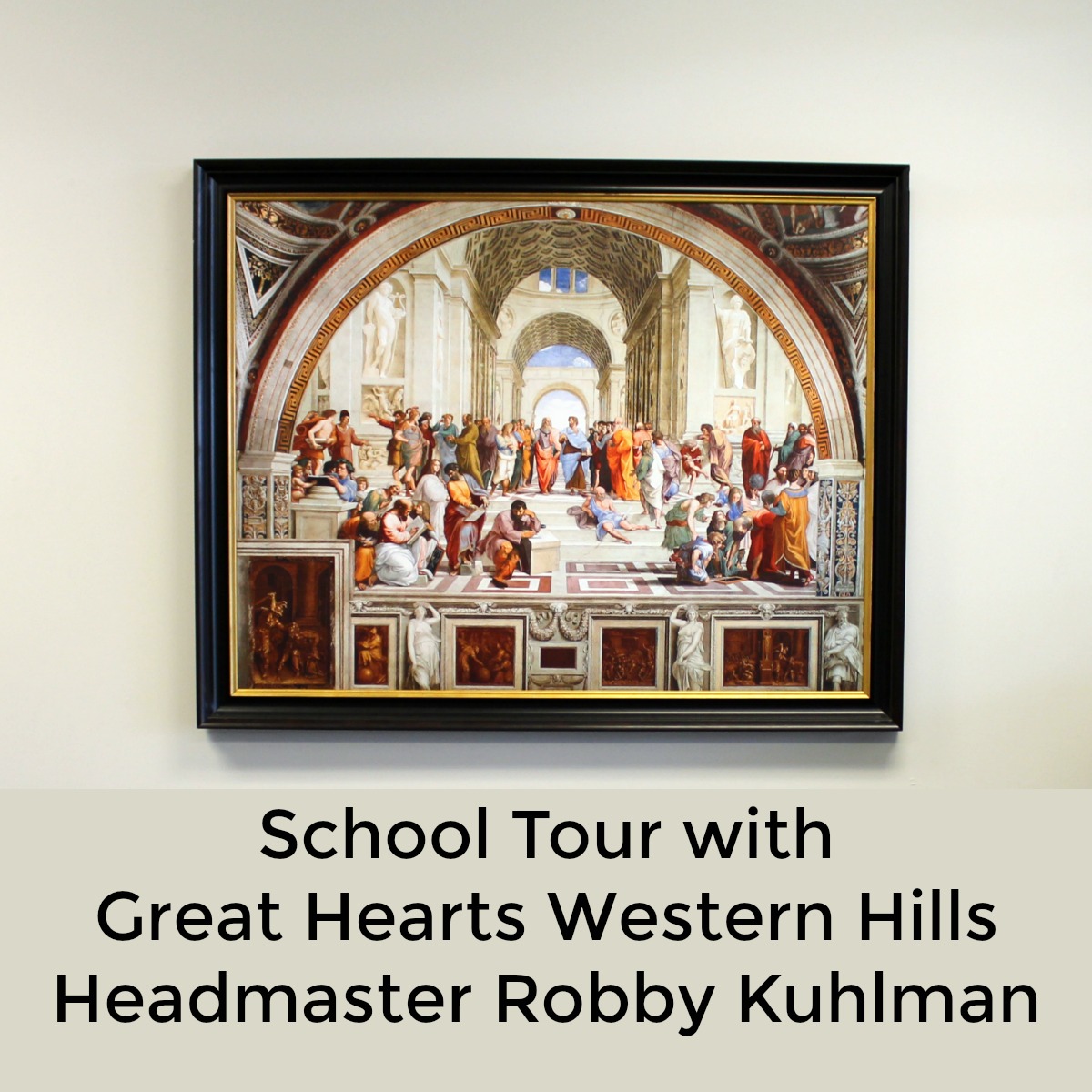
Robby Kuhlman is the Headmaster of Great Hearts Western Hills, the new campus in the Great Hearts Academies network of public charter schools that recently broke ground on the west side of San Antonio. Kuhlman has been meeting with prospective families and leading tours at Great Hearts Northern Oaks, a campus on the north side that opened in 2015. I recently joined one of these tours and wanted to share my impressions with readers who may be considering applying to Great Hearts, which is holding open enrollment through December 11, 2017. Kuhlman has many years of experience as a teacher and school leader at Great Hearts, and the new Western Hills campus is likely to continue the tradition of high-quality, classical education public charter schools.
Great Hearts Curriculum
My own children attend school at Great Hearts Monte Vista, so I encounter the curriculum at homework time every day, but I always learn more when I have the opportunity to hear from Great Hearts school leaders about the choices underlying the curriculum.
Every Great Hearts campus prominently features a reproduction of Raphael’s School of Athens. At the center of a large plaza, Plato and Aristotle are having a conversation and asking important questions like, “Who is man?” and “What is his place in the world?” Around them, more philosophers are talking in groups. The prominent location of the painting is a statement that the purpose of the school is to introduce students to a great conversation that has been ongoing since the beginning of humanity.
On the campus tour, Kuhlman (assisted by Great Hearts Northern Oaks K–6 Headmaster Trinette Keffer) went into detail about how that great, ancient conversation is brought to life for the present day through the Great Hearts curriculum. Here are some key elements.

Spalding is a phonics-based program for reading, spelling, and handwriting—including cursive. We observed a first-grade class reciting the syllables of words in unison, including the final silent “e” in “house.” Through a system of phonograms and rules, students can figure out the spelling and pronunciation of most English words, and learn to read with confidence.

The Socratic method guides students in productive discussions of literature and history. Students are encouraged to support their assertions by referring back to the text. Young students learn discussion skills, and by 9th–12th grades the approach blossoms into two-hour Humane Letters seminars. On our tour, we heard fifth grade students offer explanations for what the voyagers on the Dawn Treader (referring to statement by Trinian on page 256) thought about a mysterious white substance.

Singapore Math helped that small nation to improve its test scores, and at Great Hearts it helps students learn the underlying purpose of math, not just problem-solving methods. We observed a fourth-grade class studying fractions by looking an image from an overhead document camera of little toy bears grouped in circles; the teacher led the students in a Socratic discussion about different ways to multiply the fractions. Also, Rocket Math offers timed exercises to boost knowledge of math facts and make it easier for students to solve math problems (despite the presence of idioms like “litres of petrol” and units like “mangoes and guavas”).
Core Knowledge has grade-specific lists of objectives in subjects such as history and science. Each grade level builds on material that the students learned the year before. The cumulative effect is to fill students with the knowledge they need to be well-informed citizens. Also, topics covered in Core Knowledge are carried across the curriculum into art and music.
“Specials” subjects, including art and music, are offered 2–3 times per week with a goal of creating well-rounded students. Chess is part of the curriculum; students learn basic skills, then advance to strategies and tactics. They study chess notation and participate in tournaments. P.E. is also offered 2–3 times per week and builds skills that students will use in team sports that are offered in middle school.

Latin will help students build vocabulary and understand grammar concepts like tense and subject-verb agreement. In high school, students may choose to continue studying classical languages (two years each of Latin and Ancient Greek) or switch to a modern language (Spanish, French). (Note: Monte Vista and Northern Oaks offer Spanish at the Lower School.)
Kuhlman emphasized that all of these subjects are taught at an honors level, and that high level of instruction is available to all students—including those qualifying for special education services. At Great Hearts Northern Oaks, 12 percent of the students receive special education services, which is higher than the 8 percent in surrounding North East ISD.
Great Hearts School Model
The mood at a Great Hearts campus is calm and orderly, but also joyful. The students practice routines and transitions so that they quickly ready to learn. The teachers remain calm and use techniques like call-and-response (“Class, class!” “Yes, yes!”), hand clapping, and songs to signal transitions and keep all students working together. Students join in the songs and stretch their hands high, showing that they are eager to participate.
Classroom management is especially important because of class size. At Great Hearts Northern Oaks, for grades K–3, there are 30 students per class and one lead teacher plus one apprentice teacher. For grades 4–6, there are also 30 students and one lead teacher per class, and two apprentice teachers are shared across four sections.
Keffer explained how Great Hearts students are expected to leave pop culture at the door. She hopes that students will form bonds based on their character, not a shared interest in a pop culture figure. On campus, the students are reading and learning the same things, and that is their shared culture and what they discuss.
Public charter schools do not receive the same funding for facilities as traditional public schools, so at Great Hearts Northern Oaks, the school has been raising money for expanded buildings through a capital campaign. Public charter schools receive about $1,500 less per student than traditional public schools, and so the school manages a community investment campaign to ask parents to help make up the difference.
As public schools, Great Hearts must administer the STAAR test to students. The teachers get students ready through the Great Hearts curriculum, not through hype or pep rallies. Keffer emphasized that Great Hearts is not a sink-or-swim culture: students who struggle get extra help, and the staff includes math and reading interventionists to support students, including students with special needs.
“Our calling is to graduate great-hearted young men and women,” Kuhlman said. “We care about their moral stance. We want them to be filled with virtue.” That approach is graduating students who are gaining admission to selective colleges and earning millions of dollars in scholarships. As Kuhlman pointed out, the classical education model has been proven over time. Great Hearts is going back to principles that have been successful in the past and is reviving them for today.

About Western Hills
Great Hearts Western Hills will be located at 8702 Ingram Rd., San Antonio, TX 78245 (map), at the southeast corner of Ingram Road and Midhurst Avenue. The campus—see how it will look here—will open in August 2018 serving grades K–5 and expanding every year until it is a full K–12 campus. Open enrollment began today and will continue through December 11, 2017. It’s likely that more students will apply than there are spaces available, so the school will hold a lottery in January 2018 to determine placement on the waiting list.

Parents have many options for getting more information about Great Hearts during open enrollment.
- The next tour with Headmaster Kuhlman will be on November 15, and additional tour dates are scheduled.
- Visit the Tour an Academy page to register for school tours at other campuses.
- Attend a Great Hearts San Antonio info night in your part of town.
- Join a info session on Facebook Live at 6 p.m. tonight—Monday, November 13.
- Call the enrollment hotline at 210-888-9475, ext. 2 or ext. 3.
- Email enrollment questions to GH.Enrollment@GreatHeartsTX.org.
- Send a private message through the Great Hearts Texas Facebook page.
Great Hearts came to San Antonio in 2014 and quickly established three strong campuses, as you can see from the 2017 accountability reports from Great Hearts Monte Vista South (K–5), Great Hearts Monte Vista North (6–12), and Great Hearts Northern Oaks (K–9). (For more information, see the Texas Education Agency’s Department of Performance Reporting.) The Great Hearts classical education model is distinctly different from what is being offered at traditional public schools in San Antonio. Kuhlman’s experience as a teacher and school leader means that the Western Hills campus is likely to be another high-performing charter school in the classical tradition—welcome news for the more than 4,000 students on waiting lists for Great Hearts in San Antonio.
Read more:
- “Groundbreaking Ceremony at Great Hearts Western Hills,” Inga Cotton, San Antonio Charter Moms, September 11, 2017
- “Building a School Community: Notes from the Great Hearts Monte Vista Open House,” Inga Cotton, San Antonio Charter Moms, April 13, 2014
